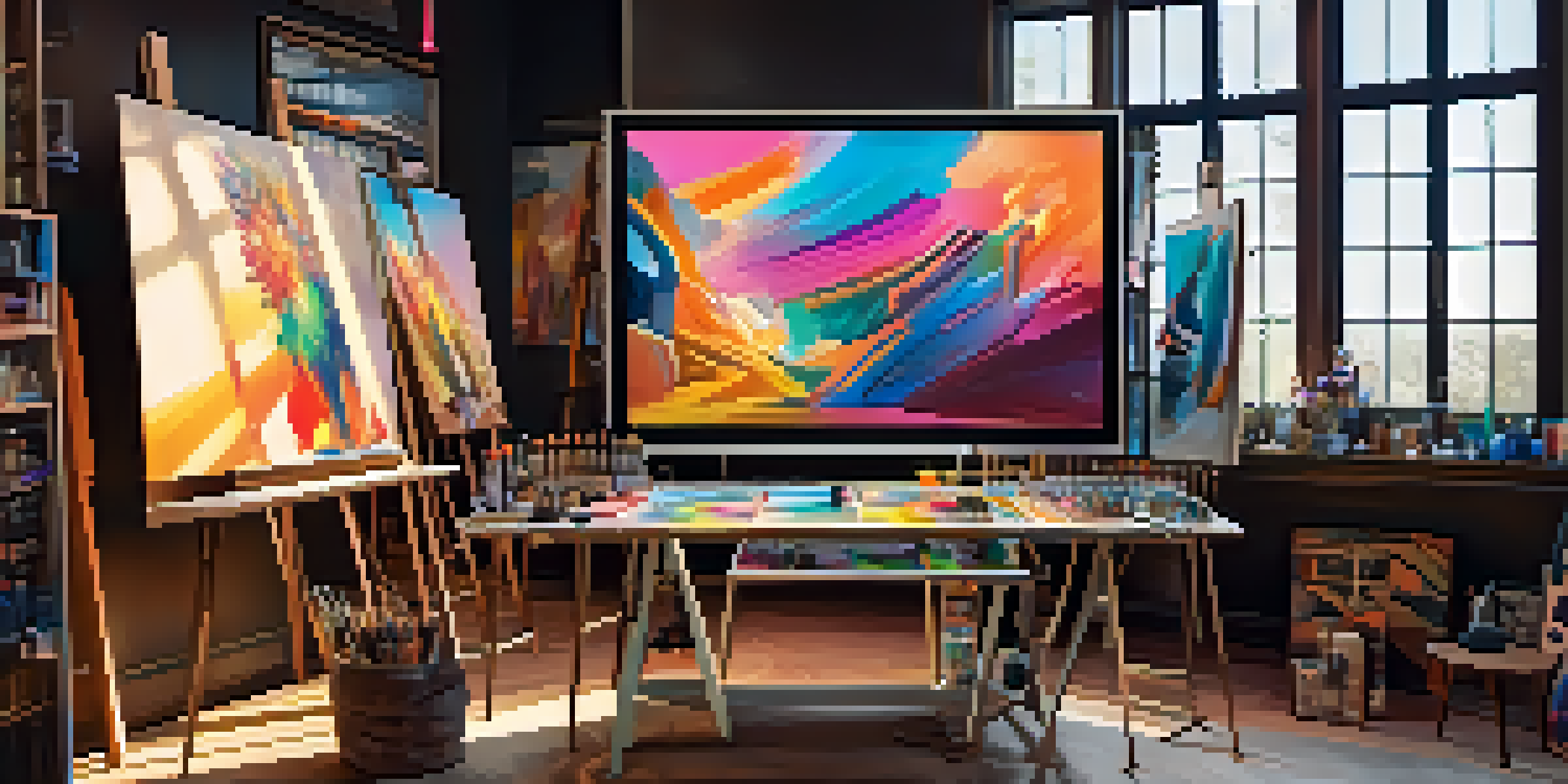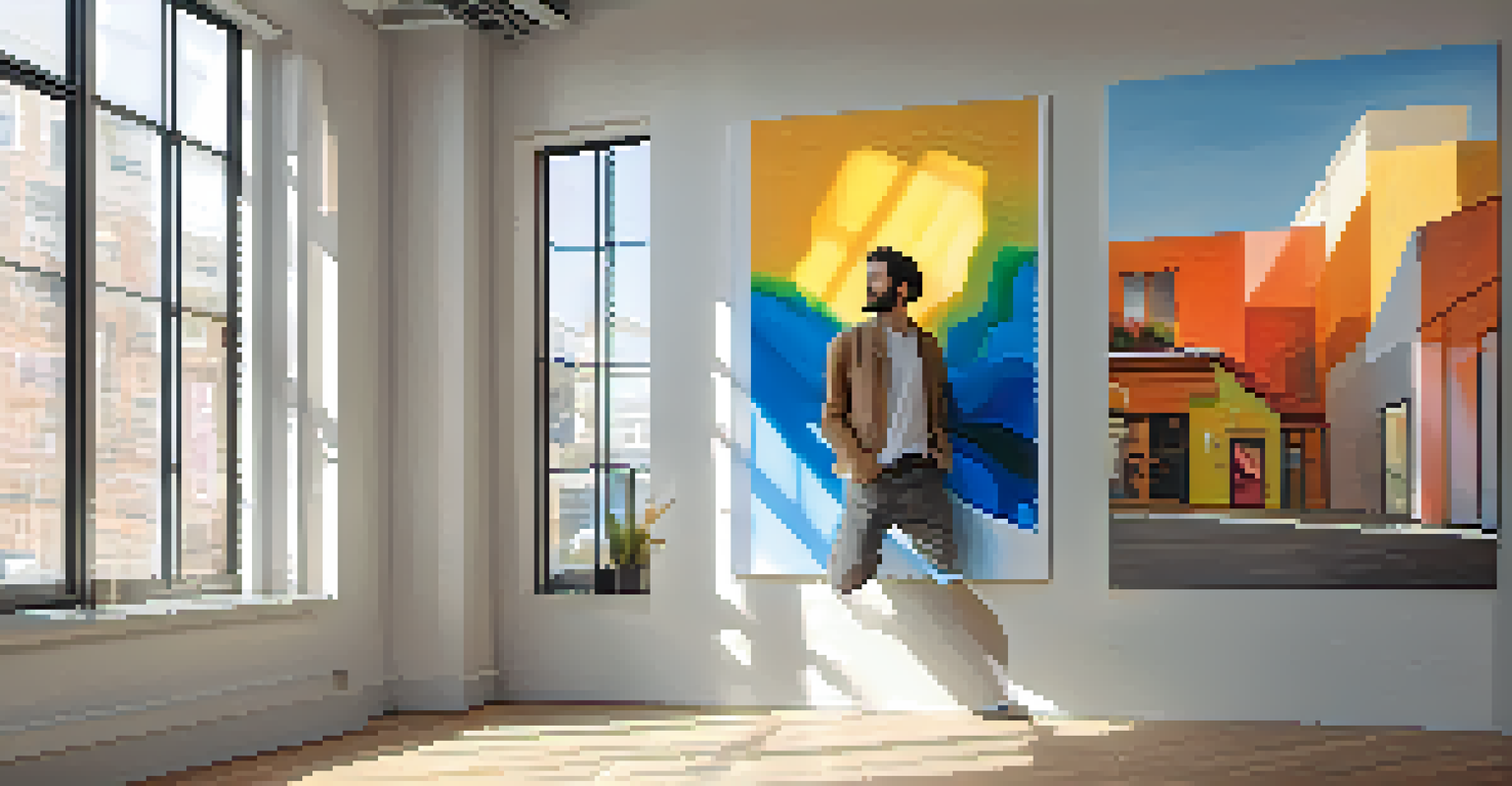The Intersection of Technology and Artistic Innovation

The Evolution of Art Through Technological Advancements
Over the centuries, art has continually evolved, often influenced by technological advancements. From the invention of the printing press to the rise of photography, each innovation has opened new avenues for artists. Today, technology like digital tools and software is redefining how art is created and consumed. This evolution highlights the symbiotic relationship between art and technology, where each inspires and enhances the other.
Art is not freedom from discipline, but disciplined freedom.
For instance, consider how digital painting software allows artists to experiment with styles and techniques without the limitations of traditional mediums. Artists can easily undo mistakes or explore different color palettes at the click of a button, which encourages creativity. Additionally, this technology allows for the creation of intricate designs that might have been impossible with traditional tools, showcasing the endless possibilities available in the digital age.
Moreover, as technology progresses, it continues to democratize art, enabling anyone with a computer or tablet to become an artist. Platforms like social media provide artists a global stage where they can share their work and connect with audiences and other creators. This accessibility has led to a flourishing of diverse artistic expressions, making art more inclusive and representative of various cultures and perspectives.
The Role of Artificial Intelligence in Artistic Creation
Artificial intelligence (AI) is becoming an influential player in the art world, sparking debates about creativity and originality. AI tools can analyze vast datasets to generate artwork, music, or even poetry, pushing the boundaries of what we consider 'art.' This technology raises questions about the nature of creativity: can a machine truly create, or is it merely a reflection of human input?

One fascinating example is the use of AI to create visual art, where algorithms are trained on existing works to produce new pieces. The resulting artworks can sometimes be indistinguishable from those created by human hands, showcasing AI's potential to innovate. However, while AI can mimic styles, the emotional depth and intention behind human-created art remain unique, reminding us of the irreplaceable human touch.
Art and Technology's Symbiotic Dance
Technological advancements continuously reshape art creation and consumption, fostering creativity and accessibility.
Furthermore, AI can serve as a collaborator rather than a competitor. Artists can use AI-generated suggestions to inspire their work or explore new directions. This partnership illustrates how technology can enhance artistic practices, allowing creators to push their boundaries while still maintaining their individual voices.
Virtual Reality: A New Dimension for Artistic Experience
Virtual reality (VR) is revolutionizing how audiences experience art, transforming static exhibitions into immersive environments. Through VR, viewers can step into a painting or explore a sculpture from every angle, engaging with art in ways previously unimaginable. This technology not only enhances the viewer's experience but also invites new forms of artistic expression that blend visuals with interactive storytelling.
The future belongs to those who believe in the beauty of their dreams.
For instance, VR art installations allow artists to create entire worlds that audiences can explore, creating a sense of presence and connection. Imagine walking through an abstract landscape where the colors and forms shift as you move; this is the power of VR in the art realm. Such experiences can evoke strong emotions and provoke thought, fostering a deeper understanding and appreciation of the artist's vision.
Moreover, VR brings art to those who may not have access to traditional galleries or museums. Virtual exhibitions can reach global audiences, making art more accessible than ever. This accessibility not only broadens the viewer base but also introduces diverse voices and narratives into the art conversation, enriching the cultural landscape.
The Impact of Social Media on Artistic Trends
Social media platforms have transformed the way art is shared and consumed, creating a vibrant online community for artists and fans. Platforms like Instagram and TikTok allow creators to showcase their work directly to a global audience, bypassing traditional gatekeepers like galleries. This shift has led to the rapid spread of artistic trends and styles, influencing what is considered popular or relevant in the art world.
For example, the rise of 'Instagram art' has popularized certain aesthetics, leading to the emergence of artists who gain fame through social media exposure. This phenomenon highlights how quickly trends can evolve and spread, allowing new artists to gain recognition overnight. However, it also raises questions about authenticity and the pressure to produce content that garners likes and shares.
AI as a Collaborative Artistic Tool
Artificial intelligence enhances artistic practices by offering innovative suggestions while preserving the unique human touch.
Additionally, social media fosters collaboration and community among artists. Creators can connect, share techniques, and inspire each other, creating a sense of belonging. This interconnectedness not only enriches individual practices but also contributes to a collective evolution in the art scene, making it more dynamic and diverse.
Digital Art: Redefining Traditional Boundaries
Digital art has emerged as a legitimate form of creative expression, challenging the traditional definitions of art. With tools like graphic tablets and digital software, artists can explore new techniques that blend painting, photography, and design. This shift has led to a broader acceptance of digital art within the art community, showcasing its ability to stand alongside more conventional forms.
One significant aspect of digital art is its versatility; artists can easily switch between styles, create interactive pieces, or even animate their work. This flexibility encourages experimentation, allowing artists to push the boundaries of their creativity. Furthermore, digital art can be reproduced infinitely without losing quality, making it easier for artists to share their work with a wider audience.
However, the rise of digital art also brings challenges, such as questions of copyright and ownership. As artists create pieces that can be easily replicated and shared online, the need to establish clear guidelines for attribution and usage becomes crucial. Navigating these issues is essential for protecting artists' rights while fostering a thriving digital art community.
The Rise of NFTs and Their Influence on Art
Non-fungible tokens (NFTs) have taken the art world by storm, offering a new way for artists to monetize their work. By converting digital art into unique tokens on the blockchain, artists can sell their creations while retaining ownership and provenance. This innovation has opened up exciting opportunities for creators, allowing them to reach collectors and enthusiasts in unprecedented ways.
For instance, digital artists can now sell their work directly to buyers without going through traditional galleries, making the art market more accessible. This direct connection fosters a sense of community and collaboration, as artists can engage with their supporters and fans more intimately. However, the NFT market is also subject to volatility, raising concerns about sustainability and long-term value.
NFTs Redefine Ownership in Art
Non-fungible tokens transform the art market by allowing artists to monetize their digital creations while questioning traditional notions of ownership.
Moreover, NFTs challenge our understanding of ownership in the digital age. While collectors can own a piece of digital art, the image itself can still be shared and viewed by anyone online. This duality invites discussions about the nature of value and exclusivity in art and prompts artists to rethink how they present their work in a rapidly changing landscape.
The Future: Merging Technology and Art for Innovation
As technology continues to advance, the future of art promises to be even more dynamic and innovative. We can expect to see increased integration of augmented reality (AR) and artificial intelligence, creating experiences that blur the lines between the physical and digital worlds. This merging of technology and art will likely lead to new forms of expression and interaction that we can't yet imagine.
For example, imagine walking through a gallery where the art responds to your movements or emotions, creating a personalized experience. This kind of interactivity could change how we engage with art, making it more immersive and meaningful. As artists embrace these technologies, we may see a rise in collaborative projects that involve multiple disciplines, further expanding the creative landscape.

Ultimately, the intersection of technology and artistic innovation holds immense potential for both artists and audiences. By embracing these changes, artists can continually redefine their practices and challenge conventional norms, leading to a richer, more diverse art world. As we move forward, the dialogue between technology and art will remain vital, reflecting our evolving society and culture.